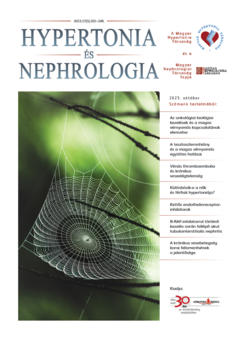The eLitMed.hu medical portal uses computer cookies for convenient operation. Detailed information can be found in the Cookie-policy.
Specialities
Diabetology
[High blood pressure and low testosterone levels both increase the risk of cardiovascular disease and alter the morphology and function of blood vessels]
[Both hypertension and andropause alone increase the risk of cardiovascular disease. The incidence of both diseases increases with age. As a consequence they may often present concurrently in men. The damaging effects of the two noxae may add up - this may be observed in the remodeling processes of coronary resistance vessels. This mini-review summarizes the effects of hipertension, testosterone deficiency and the combined effects of these two noxae on the morphological, biomechanical and functional adaptation of coronary resistance vessels, as well as on cardiovascular diseases.]
[Is hypertension different for women and men?]
[Hypertension is a risk factor for cardiovascular diseases in both men and women. Lifelong studies have proven that women suffer from high blood pressure in old age more often than men and this is often associated with obesity, dyslipidemia, and diabetes. All of this can most likely be related to menopause, when one of the most important female sex hormones, estrogen’s vascular protective and anti-inflammatory effect ceases. It has also been proven that pregnancy is also a test for the vascular system. Pathological abnormalities during pregnancy increase the cardiovascular risk later on. Differences can be detected in the regulation of blood pressure, as a result of the autonomic nervous system and hormonal effects. Differences can also be discovered in relation to common cardiovascular diseases. Although the recommendations do not currently differentiate, the effectiveness of the therapies and the frequency of side effects may also differ. Recent researches conclude that women’s cardiovascular risk is manifested in lower blood pressure values than men’s. It is possible that we should modify the threshold and target values of women’s blood pressure in order to decrease the proven cardiovascular risk of high blood pressure in women through well-planned therapy.]
1.
Clinical Neuroscience
[Headache registry in Szeged: Experiences regarding to migraine patients]2.
Clinical Neuroscience
[The new target population of stroke awareness campaign: Kindergarten students ]3.
Clinical Neuroscience
Is there any difference in mortality rates of atrial fibrillation detected before or after ischemic stroke?4.
Clinical Neuroscience
Factors influencing the level of stigma in Parkinson’s disease in western Turkey5.
Clinical Neuroscience
[The effects of demographic and clinical factors on the severity of poststroke aphasia]1.
2.
Clinical Oncology
[Pancreatic cancer: ESMO Clinical Practice Guideline for diagnosis, treatment and follow-up]3.
Clinical Oncology
[Pharmacovigilance landscape – Lessons from the past and opportunities for future]4.
5.




